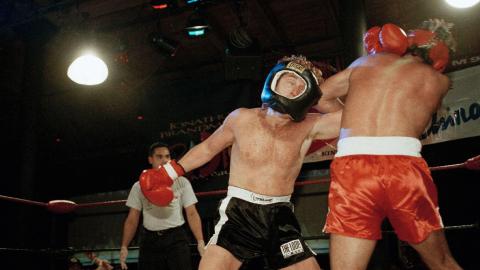How did the SAS carry out its first postwar covert operations?
In this guest article Tim Jones, author of SAS: The First Secret Wars, recounts the SAS's critical fight for survival and how t was saved from total disbandment after WW2.
Until SAS: The First Secret Wars was published in 2005 (updated 2010), there was next to nothing known about SAS activities between 1945 and its apparently phoenix-like re-emergence in Malaya in 1950. Even senior officers in the Regiment were unaware of the actions of a few key figures who saved it from total disbandment. This was underlined when I spoke at Hereford in 2013 about the SAS’s most crucial fight, for survival, at the end of the War. As one officer kindly noted after my presentation, 'it was fascinating and we all learnt a huge amount' from 'a really interesting talk'.
The seeds of the campaign for a postwar role were sown in autumn 1944 by a few officers in the upper echelons of the military and intelligence communities. They foresaw the impending defeat of Nazi Germany, and the SAS’s Liaison to SIS ( Secret Intelligence Service) and SOE (Special Operations Executive), Lt-Col Ian Collins, lobbied from October 1944 for a continued SAS role after hostilities. At that point, a Foreign Office report recommended that any future secret organisation operating overseas should do so under the SIS’s umbrella.
The SIS and the SOE were in Athens, when a Communist revolt erupted that December and the SAS had an observer, Maj Roy Farran. A week after Hitler’s death, in May 1945, Lt-Col Collins proposed future SAS missions should include observing and operating in civil wars like Spain’s that took place from 1936-39. In June, the SAS’s Commanding Officer (CO), Brigadier Mike Calvert, wrote to the Chief of the Imperial General Staff (CIGS) Alanbrooke, suggesting a counterinsurgency role for the SAS.
The War Office pondered the future of special forces up to October 1945, when the SAS received disbandment orders and most of the 1st and 2nd SAS regiments dispersed. But Calvert and the HQ continued to lobby for a role, in cooperation with SOE. Both organisations highlighted the worsening internal situation in Greece, but with Calvert transferred to India, it fell to CO, Lt-Col Brian Franks, of the 2nd SAS regiment to drive the SAS’s lobbying forward. As chair of the new Regimental Association of ‘old hands’, with help from CO, Maj Harry Poat of the 1st SAS regiment, he secured War Office permission for SAS HQ to continue to the end of November 1945 to organise 'volunteer' contingents for 'special jobs'. These included SAS War Crimes Teams in Germany, tracking down Nazi war criminals, and a group attached to MI9’s Allied Screening Commission (Greece), tasked with verifying claims from Greeks who’d assisted Allied escapers and evaders.
Just before the SAS HQ wound down, 10 SAS officers attached as Intelligence Corps 'Intelligence Officers', and about 20 Other Ranks, joined the ASC(G) (Allied Screening Commission Greece). They faced a rapidly deteriorating situation as Greek Left and Right irregulars carried out 'banditry', and at least half a dozen SAS Mobile Teams were despatched about Greece, with a mission deadline of 31 May. In December 1945, occupying British Forces in Greece were instructed to stay out of Internal Security in the run-up to the 31 March 1946 national election, while the SAS apparently suffered at least two fatalities including Lt Ivan Parry-Jones of the Special Boat Service (SBS).
With matters worsening, on 7 February, the War Office directed ASC(G) to stop taking claims and, on 8 February, the War Office moved to effect the delayed 'formal disbandment' of the SAS. Its Greek mission seemed over, but, in January 1946, the SIS absorbed into its ranks 280 personnel from the disbanding SOE and created a Directorate Of War Planning that was active by mid-1946. Lt-Col Franks began working for it at some point that year and, as the UK Chiefs Of Staff approved training in 'modern guerrilla warfare' for the new Greek National Army on 20 February, it seems that Franks arranged to transfer the SAS Mobile Teams to a new home, the War Office’s Paramilitary Establishment, the British Reparations Mission in Greece.
By May 1946, the Foreign Office supported British assistance in Greek Internal Security, while the SIS set up a regional 'main station' in Athens. At the end of June, the War Office was preparing to remove the SAS from the Army List, though this was delayed until August, when the SAS and SOE were officially wound up. Yet SOE personnel continued to work in SIS, and it seems that the SAS came under its umbrella in Greece. By 20 September, the War Office concluded that 'special units' would be needed going forward, alongside SIS, and, in November, the CIGS, Montgomery, approved plans for Greek Commando special forces, while the SIS was to come under Foreign Office direction of 'unacknowledgeable activities'.
That month, the War Office backed a Territorial Army from 1947, including a SAS unit. In December 1946, the War Office despatched SAS advisors to the Greek Army for covert counterinsurgency training, which went on from January 1947 to October 1948, while some remained in the field into 1949, when the Greek Civil War was successfully concluded. A key factor in this was the clandestine role of the SAS (covered-up by the Foreign Office for 60 years), and the Regiment’s use of its Whitehall political and personal connections to fight its most critical battle, for survival, while carving out a new role in counterinsurgency that has continued to this day.
















